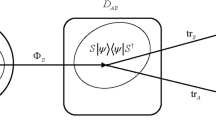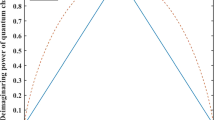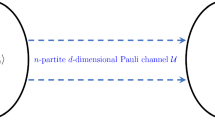Abstract
Quantum information masking encodes an arbitrary quantum state into a multipartite system such that the original information of input states is completely unknown to local subsystems. In this work, we investigate the quantitative distribution of quantum information masking. We regard quantum information maskers as quantum broadcasting channels and propose the Holevo’s quantity as a measure of the information carried by local subsystems. Based on the theory of quantum channels, we first give necessary and sufficient conditions for the existence of perfect quantum information masking. Then, we investigate information recovery from the union of local subsystems. We find a close connection between quantum information masking and codes for quantum erasing channels, by which the no-masking theorem is rediscovered from the point of view of information transmission. Finally, we discuss the storage behavior of quantum information and propose that quantum information can reside in the correlations of subsystems in a redundant way. Our work deepens the understanding of the way that quantum information resides.



Similar content being viewed by others
Data availability
Data sharing is not applicable to this article as no new data were generated or analyzed in this study.
References
Nielsen, M.A., Chuang, I.L. Quantum Computation and Quantum Information: 10th Anniversary Edition. Cambridge University Press, Cambridge (2010). https://doi.org/10.1017/CBO9780511976667
Wilde, M.M.: Quantum Information Theory, 2nd edn. Cambridge University Press, Cambridge (2017). https://doi.org/10.1017/9781316809976
Wootters, W.K., Zurek, W.H.: A single quantum cannot be cloned. Nature 299(5886), 802–803 (1982). https://doi.org/10.1038/299802a0
Dieks, D.: Communication by EPR devices. Phys. Lett. A 92(6), 271–272 (1982). https://doi.org/10.1016/0375-9601(82)90084-6
Wang, M., Cai, Q.: Duplicating classical bits with universal quantum cloning machine. Sci. China Phys. Mech. Astron. 62(3), 1 (2018). https://doi.org/10.1007/s11433-018-9296-3
Pati, A.K., Braunstein, S.L.: Impossibility of deleting an unknown quantum state. Nature 404(6774), 164–5 (2000). https://doi.org/10.1038/404130b0
Braunstein, S.L., Pati, A.K.: Quantum information cannot be completely hidden in correlations: implications for the black-hole information paradox. Phys. Rev. Lett. 98, 080502 (2007). https://doi.org/10.1103/PhysRevLett.98.080502
Samal, J.R., Pati, A.K., Kumar, A.: Experimental test of the quantum no-hiding theorem. Phys. Rev. Lett. 106, 080401 (2011). https://doi.org/10.1103/PhysRevLett.106.080401
Bennett, C.H., Brassard, G.: Quantum cryptography: public key distribution and coin tossing. Theor. Comput. Sci. 560, 7–11 (2014). https://doi.org/10.1016/j.tcs.2014.05.025
Gisin, N., Thew, R.: Quantum communication. Nat. Photon. 1(3), 165–171 (2007). https://doi.org/10.1038/nphoton.2007.22
Bennett, C.H., Wiesner, S.J.: Communication via one- and two-particle operators on Einstein–Podolsky–Rosen states. Phys. Rev. Lett. 69, 2881–2884 (1992). https://doi.org/10.1103/PhysRevLett.69.2881
Guo, Y., Liu, B.-H., Li, C.-F., Guo, G.-C.: Advances in quantum dense coding. Adv. Quant. Technol. 2(5–6), 1900011 (2019). https://doi.org/10.1002/qute.201900011
Bennett, C.H., Brassard, G., Crépeau, C., Jozsa, R., Peres, A., Wootters, W.K.: Teleporting an unknown quantum state via dual classical and EPR channels. Phys. Rev. Lett. 1, 1895–1899 (1993). https://doi.org/10.1103/PhysRevLett.70.1895
Bouwmeester, D., Pan, J.-W., Mattle, K., Eibl, M., Weinfurter, H., Zeilinger, A.: Experimental quantum teleportation. Nature 390(6660), 575–579 (1997). https://doi.org/10.1038/37539
Modi, K., Pati, A.K., Sen, A., Sen, U.: Masking quantum information is impossible. Phys. Rev. Lett. 120, 230501 (2018). https://doi.org/10.1103/PhysRevLett.120.230501
Li, M.-S., Wang, Y.-L.: Masking quantum information in multipartite scenario. Phys. Rev. A 98, 062306 (2018). https://doi.org/10.1103/PhysRevA.98.062306
Li, B., Jiang, S.-H., Liang, X.-B., Li-Jost, X., Fan, H., Fei, S.-M.: Deterministic versus probabilistic quantum information masking. Phys. Rev. A 99, 052343 (2019). https://doi.org/10.1103/PhysRevA.99.052343
Li, M.-S., Modi, K.: Probabilistic and approximate masking of quantum information. Phys. Rev. A 102, 022418 (2020). https://doi.org/10.1103/PhysRevA.102.022418
Shang, W.-M., Zhang, F.-L., Zhou, J., Meng, H.-X., Chen, J.-L.: Qubit masking in multipartite qubit system. Modern Phys. Lett. A (2021). https://doi.org/10.1142/S021773232150156X
Du, Y., Guo, Z., Cao, H., Han, K., Yang, C.: Masking quantum information encoded in pure and mixed states. Int. J. Theor. Phys. 60(7), 2380–2399 (2021). https://doi.org/10.1007/s10773-020-04542-w
Sun, B.-Z., Fei, S.-M., Li-Jost, X.: Quantum information masking of Hadamard sets. Quantum Inf. Process. 20(10), 324 (2021). https://doi.org/10.1007/s11128-021-03253-3
Liu, Z.-H., Liang, X.-B., Sun, K., Li, Q., Meng, Y., Yang, M., Li, B., Chen, J.-L., Xu, J.-S., Li, C.-F., Guo, G.-C.: Photonic implementation of quantum information masking. Phys. Rev. Lett. 126, 170505 (2021). https://doi.org/10.1103/PhysRevLett.126.170505
Zhang, R.-Q., Hou, Z., Li, Z., Zhu, H., Xiang, G.-Y., Li, C.-F., Guo, G.-C.: Experimental masking of real quantum states. Phys. Rev. Appl. 16, 024052 (2021). https://doi.org/10.1103/PhysRevApplied.16.024052
Shi, F., Li, M.-S., Chen, L., Zhang, X.: \(k\)-uniform quantum information masking. Phys. Rev. A 104, 032601 (2021). https://doi.org/10.1103/PhysRevA.104.032601
Han, K.Y., Guo, Z.H., Cao, H.X., Du, Y.X., Yang, C.: Quantum multipartite maskers vs. quantum error-correcting codes. Europhys. Lett. 131(3), 30005 (2020). https://doi.org/10.1209/0295-5075/131/30005
Lie, S.H., Choi, S., Jeong, H.: Min-entropy as a resource for one-shot private state transfer, quantum masking, and state transition. Phys. Rev. A 103, 042421 (2021). https://doi.org/10.1103/PhysRevA.103.042421
Lie, S.H., Kwon, H., Kim, M.S., Jeong, H.: Quantum one-time tables for unconditionally secure qubit-commitment. Quantum 5, 405 (2021). https://doi.org/10.22331/q-2021-03-10-405
Bai, C.-M., Zhang, S., Liu, L.: Quantum secret sharing based on quantum information masking. Quantum Inf. Process. 21(11), 377 (2022). https://doi.org/10.1007/s11128-022-03723-2
Lv, Q.-Q., Liang, J.-M., Wang, Z.-X., Fei, S.-M.: Quantum information masking in non-Hermitian systems and robustness. Laser Phys. Lett. 19(4), 045203 (2022). https://doi.org/10.1088/1612-202X/ac52b1
Hu, M., Chen, L.: Genuine entanglement, distillability and quantum information masking under noise. Quantum Inf. Process. 21(5), 162 (2022). https://doi.org/10.1007/s11128-022-03497-7
Shen, Y., Zhang, F.-L., Chen, Y.-Z., Zhou, C.-C.: Masking quantum information in the Kitaev Abelian Anyons. Physica A 612, 128495 (2023). https://doi.org/10.1016/j.physa.2023.128495
Bužek, V., Hillery, M.: Quantum copying: Beyond the no-cloning theorem. Phys. Rev. A 54, 1844–1852 (1996). https://doi.org/10.1103/PhysRevA.54.1844
Scarani, V., Iblisdir, S., Gisin, N., Acín, A.: Quantum cloning. Rev. Mod. Phys. 77, 1225–1256 (2005). https://doi.org/10.1103/RevModPhys.77.1225
Fan, H., Wang, Y.-N., Jing, L., Yue, J.-D., Shi, H.-D., Zhang, Y.-L., Mu, L.-Z.: Quantum cloning machines and the applications. Phys. Rep. 544(3), 241–322 (2014). https://doi.org/10.1016/j.physrep.2014.06.004
Wang, M.-H., Cai, Q.-Y.: High-fidelity quantum cloning of two nonorthogonal quantum states via weak measurements. Phys. Rev. A 99, 012324 (2019). https://doi.org/10.1103/PhysRevA.99.012324
Mayers, D.: Unconditionally secure quantum bit commitment is impossible. Phys. Rev. Lett. 78, 3414–3417 (1997). https://doi.org/10.1103/PhysRevLett.78.3414
Kent, A.: Unconditionally secure bit commitment. Phys. Rev. Lett. 83, 1447–1450 (1999). https://doi.org/10.1103/PhysRevLett.83.1447
Danan, A., Vaidman, L.: Practical quantum bit commitment protocol. Quantum Inf. Process. 11(3), 769–775 (2012). https://doi.org/10.1007/s11128-011-0284-4
Devitt, S.J., Munro, W.J., Nemoto, K.: Quantum error correction for beginners. Reports on progress in physics. Phys. Soc. (Great Br.) 76, 076001 (2013)
Hillery, M., Bužek, V., Berthiaume, A.: Quantum secret sharing. Phys. Rev. A 59, 1829–1834 (1999). https://doi.org/10.1103/PhysRevA.59.1829
Gottesman, D.: Theory of quantum secret sharing. Phys. Rev. A 61, 042311 (2000). https://doi.org/10.1103/PhysRevA.61.042311
Schumacher, B., Westmoreland, M.D.: Quantum mutual information and the one-time pad. Phys. Rev. A 74, 042305 (2006). https://doi.org/10.1103/PhysRevA.74.042305
Holevo, A.S.: Quantum Systems, Channels, Information. De Gruyter, Berlin, Boston (2013). https://doi.org/10.1515/9783110273403
Holevo, A.S.: Quantum channel capacities. Quantum Elec. 50(5), 440 (2020). https://doi.org/10.1070/QEL17285
Holevo, A.S.: Bounds for the quantity of information transmitted by a quantum communication channel. Probl. Peredachi Inf. 9, 3–11 (1973)
Holevo, A.S.: The capacity of the quantum channel with general signal states. IEEE Trans. Inform. Theory 44(1), 269–273 (1998). https://doi.org/10.1109/18.651037
Schumacher, B., Westmoreland, M.D.: Sending classical information via noisy quantum channels. Phys. Rev. A 56, 131–138 (1997). https://doi.org/10.1103/PhysRevA.56.131
Grassl, M., Beth, T., Pellizzari, T.: Codes for the quantum erasure channel. Phys. Rev. A 56, 33–38 (1997). https://doi.org/10.1103/PhysRevA.56.33
Shor, P.W.: Scheme for reducing decoherence in quantum computer memory. Phys. Rev. A 52, 2493–2496 (1995). https://doi.org/10.1103/PhysRevA.52.R2493
Horodecki, R., Horodecki, P., Horodecki, M., Horodecki, K.: Quantum entanglement. Rev. Mod. Phys. 81, 865–942 (2009). https://doi.org/10.1103/RevModPhys.81.865
Uola, R., Costa, A.C.S., Nguyen, H.C., Gühne, O.: Quantum steering. Rev. Mod. Phys. 92, 015001 (2020). https://doi.org/10.1103/RevModPhys.92.015001
Clerk, A.A., Devoret, M.H., Girvin, S.M., Marquardt, F., Schoelkopf, R.J.: Introduction to quantum noise, measurement, and amplification. Rev. Mod. Phys. 82, 1155–1208 (2010). https://doi.org/10.1103/RevModPhys.82.1155
Uhlmann, A.: Relative entropy and the Wigner–Yanase–Dyson–Lieb concavity in an interpolation theory. Commun. Math. Phys. 54(1), 21–32 (1977). https://doi.org/10.1007/BF01609834
Petz, D.: Monotonicity of quantum relative entropy revisited. Rev. Math. Phys. 15(01), 79–91 (2003). https://doi.org/10.1142/S0129055X03001576
Petz, D.: Sufficient subalgebras and the relative entropy of states of a von neumann algebra. Comm. Math. Phys. 105(1), 123–131 (1986). https://doi.org/10.1007/BF01212345
Petz, D.: Sufficiency of channels over von Neumann algebras. Q. J. Math. 39, 97–108 (1988). https://doi.org/10.1093/qmath/39.1.97
Acknowledgements
This work was supported by the National Natural Science Foundation of China (under Grants No. 12105090 and No. 12074107), the Natural Science Foundation of Hubei Province of China (under Grant No. 2020CFB263), the Innovation Group Project of the Natural Science Foundation of Hubei Province of China (under Grant No. 2022CFA012), and the Program of Outstanding Young and Middle-aged Scientific and Technological Innovation Team of Colleges and Universities in Hubei Province of China (under Grant No. T2020001).
Author information
Authors and Affiliations
Corresponding authors
Ethics declarations
Conflict of interest
The authors declare no conflict of interest.
Additional information
Publisher's Note
Springer Nature remains neutral with regard to jurisdictional claims in published maps and institutional affiliations.
Appendices
Appendix A: Proof for the monotonicity of the Holevo’s quantity
Proof
Let us consider a quantum state of system Q denoted by \(\rho ^{Q}=\sum _i p_i \rho _i^{Q} \) and quantum channel \(\varepsilon : {\mathcal {B}}(\mathcal {H_Q})\rightarrow {\mathcal {B}}(\mathcal {H_{Q}})\) applied on \(\rho ^Q\), that is,
where \(E_{k}\) are Kraus operators of \(\varepsilon \). Let us introduce an environment system labeled E. By Stinespring’s theorem [1, 2], the channel \(\varepsilon \) can also be represented as
where \(\{\vert {m}\rangle ^E\}\) forms a set of orthonormal bases of E. We also introduce a reference system labeled R and initialize the whole state as follows:
where \(\{\vert {i}\rangle ^R\}\) forms a set of orthonormal bases of R. The superscript is omitted if there is no ambiguity. Applying U on systems Q and E, we obtain
By the monotonicity of quantum relative entropy [53, 54], the following inequality holds:
where \(S(\rho \Vert \sigma )\equiv Tr (\rho \log (\rho -\sigma ))\) is the quantum relative entropy of \(\rho \) and \(\sigma \). Therefore,
Since
we obtain
which is the monotonicity of the Holevo’s quantity. \(\square \)
We note that if \(\rho = \sum _i p_i \vert {\psi _i}\rangle \langle {\psi _i}\vert \), then Eq. (A11) is simplified as
Appendix B: Proof for Proposition 1
Proof
Sufficiency. Let us suppose the channel \(\varepsilon \) is reversible on \(\mathcal{Q}\mathcal{S}\); that is, there exists a reversal channel denoted by \(\varepsilon ^{-1}\) such that for any \(\rho _i\), the following equation holds:
By the monotonicity of the Holevo’s quantity, it holds that
Thus, we obtain \(S(\varepsilon (\sum _i p_i\rho _i))-\sum _i p_i S(\varepsilon (\rho _i))=S(\sum _i p_i\rho _i)-\sum _i p_iS(\rho _i)\).
Necessity. We suppose Eq. (10) is true. Let us consider the following formula:
For any \(p_i>0\) and \(\sum _i p_i =1\), we have
This results in \(\Delta _i =S(\rho _i \Vert \rho _s) - S(\varepsilon (\rho _i) \Vert \varepsilon (\rho _s))=0\) for all \(\rho _i\). By the recoverability theorem [55, 56], there exists a perfect recovery channel \(\varepsilon ^{-1}\) (depends on \(\rho _s\) and \(\varepsilon \)) such that for any \(\rho _i\),
\(\square \)
Appendix C: Proof for Proposition 2
Proof
For any mixed state \(\rho \), there exists a set of orthonormal basis \(\{\vert {e_i}\rangle \}\) such that
Let us suppose \(\varepsilon \) is a universal bleaching channel that transforms any pure input state \(\vert {\psi _i}\rangle \) into a constant state \(\sigma \), then we obtain
that is to say, the channel \(\varepsilon \) also transforms any mixed state into \(\sigma \). The \(\rho \) can also been represented by another set of orthonormal basis \(\{\vert {f_i}\rangle \}\) as \(\rho =\sum _{ij}\rho _{ij} \vert {f_i}\rangle \langle {f_j}\vert \). Therefore, we have
Thus, we obtain \(\varepsilon ( \vert {f_i}\rangle \langle {f_j}\vert )=\delta _{ij}\sigma \), where \(\delta _{ij}\) is the Kronecker delta. Here, \(\{\vert {f_i}\rangle \}\) can be any orthogonal basis.
Let \(\vert {\Psi }\rangle ^{RQ}\) be an arbitrary pure state of systems R and Q described by
where \(\{\vert {i}\rangle ^Q\}\) is the set of orthonormal basis of system Q. Applying the channel \(\varepsilon \) to the system Q, we obtain
where \(\sigma ^R=\sum _{i} p_i \vert {\psi _i}\rangle \langle {\psi _i}\vert \). This shows that the bleaching channel completely erases the information of the input system, not only the information it carries, but also all its correlations to the systems that initially entangle it. \(\square \)
Rights and permissions
Springer Nature or its licensor (e.g. a society or other partner) holds exclusive rights to this article under a publishing agreement with the author(s) or other rightsholder(s); author self-archiving of the accepted manuscript version of this article is solely governed by the terms of such publishing agreement and applicable law.
About this article
Cite this article
Zhang, S., Wang, M. & Zhou, B. Quantifying the information distribution of quantum information masking. Quantum Inf Process 22, 284 (2023). https://doi.org/10.1007/s11128-023-04036-8
Received:
Accepted:
Published:
DOI: https://doi.org/10.1007/s11128-023-04036-8




